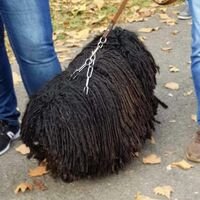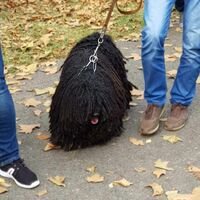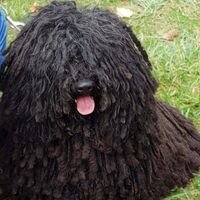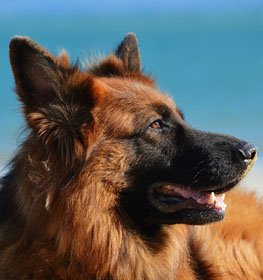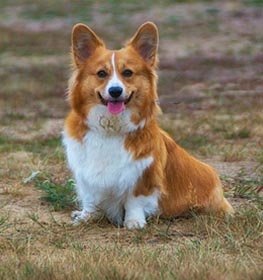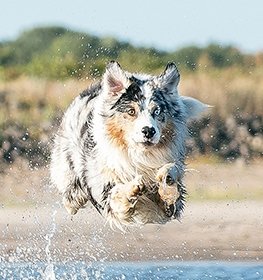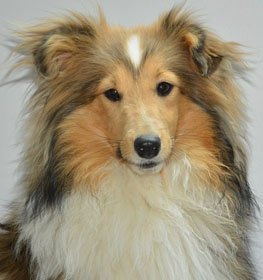Puli Information & Dog Breed Facts
Collection of all the general dog breed info about Puli so you can get to know the breed more.
| Group | Pastoral / Herding Dogs |
|---|---|
| Popularity Rank | 142 |
| Reviews | 2 |
| User Ratings | |
|
Compare the Puli With Other Dogs
Select at least one dog breed to make the comparsion. | |
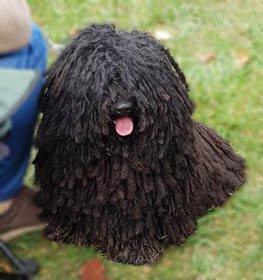 | |
| Origin | |
|
Common Names & Aliases
What other names is a Puli known by? Discover all traditional, regional and informal names used for this breed. | Hungarian Water DogPuli DogPuli KutyaPulikHungarian Puli |
|---|---|
|
Breed Classification
What type of dog breed is a Puli? Learn about its genetic classification and breeding category. | Purebred |
Overview
The Hungarian Puli is a cattle dog breed. Their trademark is the unique ribbon and tangled outer coat. A proper Puli coat might seem like a mop, as The New York Times once wrote. The Hungarian Water dog breed standard is the rounded head with a thick outer coat that is hardly separate from its body because its neck is virtually invisible due to its long hair. The soft wooly outer coat eventually cords after puppyhood. The long dense coat is heavy, but it doesn't decrease the dog's high energy level. A proper Puli coat consists of a coarse top coat and a finer undercoat. The breed standard is the advanced jaw and strong teeth. As the breed standard, their intersecting teeth are closed like scissors. His eyes are dark brown, looking intelligent, but the dense hair of the head covers the eyes as a shield. As a herding dog and a cattle dog, their sight is excellent. The Hungarian Water dog breed has wide hanging ears that are almost unnoticed from the ribbons of their coat. His back is straight and tight. As the breed standard, his tail is bent over his back, so it melts to his hair. The chest of this dog is long and deep, his belly is slightly raised. The Puli breed's limbs are well muscled, straight and parallel. The hind limbs also have good muscles. This makes the Puli a tireless and very high energy level herding dog. His paws are strong, round, black or grey.
In this Dogs 101 video, you can find a brief summary of the Puli breed information.
Photo Gallery of the Puli Breed
|
Size Classification
What size category is a Puli? Learn how big the Puli breed typically grows. | Medium |
|---|---|
|
Weight Statistics
How much does a Puli weigh? Discover typical weight ranges for adult males and females of the Puli breed. | Male: 25-35 pounds (11-16 kg), Female: 20-30 pounds (9-14 kg) |
|
Average Weight
What is the average weight of a Puli? | Male: 30 pounds (13.5 kg), Female: 25 pounds (11.5 kg) |
|
Height
How tall is the Puli? Puli height: | Male: 16-17½ inches (41-46 cm), Female: 14½-16 inches (36-41 cm) |
|
Average Height
What is the average height of a Puli? | Male: 16-17.5 inches (43.5 cm), Female: 14.5-16 inches (38.5 cm) |
|
Price Range
How much does a Puli puppy cost? Find current market prices and factors affecting Puli costs. | $1000-$1200 If you choose to purchase the Puli, you should know that the mentioned amount of money is an average of the collected data from breeders’ sites and puppy finder places. If you have a Puli for sale, please advertise it on a reliable website to make sure the Puli gets to a happy place. |
|---|---|
|
Availability
How easy is it to get a Puli? How many Puli are there in the world? | Frequent: The Puli is easier than average to get. Maybe there is some risk of overbreeding, as it is a popular breed. Due to its popularity, inbreeding may occur. A new study shows that inbreeding contributes to the incidence of disease and health problems. So be careful and seek the help of an experienced person or a professional, in making your decision. |
|
Intelligence Rating
How intelligent is a Puli? Discover the Puli's intelligence ranking and learning capabilities. | Smart: The Puli dogs have great intelligence. They understand and memorize new commands in 15-25 repetitions.
The Puli is among the smartest dogs in the intelligence ranking. |
|---|---|
|
Training Difficulty
How easy is it to train a Puli? Learn about the Puli's trainability and response to training methods. | Puli dogs are easy to train. They find out the association between commands and actions quite quickly. |
|
Watchdog Rating
How good is a Puli as a watchdog? Learn about the Puli's alertness and guarding instincts. | Puli dogs are one of the best watchdogs. Their main job is to observe and they're very consistent in their effort. The best vocal cords and sense of hearing belong to them. Usually, they're very territorial and protective about their property, so the Puli dogs will alert you if they sense something different. |
|
Territorial Protection
Is a Puli protective of its territory? Learn about the Puli's guarding instincts and behavior. | Puli dogs are extremely protective guard dogs. This breed doesn't hesitate to protect its territory so the Puli can be a good choice if you want an excellent guard dog. Keep calm and the Puli will take care of unwanted people or animals. |
|
Personality Traits
What personality does a Puli have? Learn about characteristic Puli temperament and behavior traits. | AgileEnergeticIntelligentObedientLoyalFaithfulSmartHome-Loving |
|---|---|
|
Sensitivity Level
How sensitive are they? Puli sensitivity: | They are a little bit more sensitive than other dog breeds. Soft punishment affects them emotionally. Puli dogs don't tolerate irregular daily routines, noisy households, and frequent guest visits really well.
They are receptive to their owner's emotions and make wonderful family companions. |
|
Affection Level
How affectionate are they? Is a Puli a good family dog? | Average to High: Puli dogs are highly affectionate dogs. They like being involved in the family's life. This breed isn't considered an aloof dog. |
|
Social Needs
How much social interaction does the Hungarian Water Dog need? Puli social needs: | Puli dogs need for social interaction is average. This breed likes being around people or other animals, but they don't mind being left alone for a few hours either. |
|
Impulse to Wander or Roam
How likely is the Puli to run away? Does this breed explore or wander a lot? Does Puli roam? | Puli dogs have high wanderlust potential, which means that this breed has a strong desire for exploring the world. Safer to walk them on a leash unless you teach them how to get back to you on command. This breed is also able to cause damage to your fence. |
|
Prey Drive
Do this canine have a strong prey drive? Does Puli have high prey drive? | Puli dogs have a higher impulse to chase and catch something than other dog breeds. Cats or any other small animals might be in danger. It's a natural instinct, doesn't necessarily mean that Puli dogs are aggressive. Better to keep this breed on a leash. |
|
Barking Frequency
Does a Puli bark a lot? Learn about typical Puli vocalization patterns and triggers. | Average to High: The Puli is a vocal breed. Not the best choice if you prefer a quiet breed. They often bark loudly and howl sometimes. They can change their barks depending on their emotional level and what they're trying to say. Different barks could mean the same and the same barks could have different meanings.
Top reasons for barking: protection, alarm, fear, boredom, attention-seeking, greeting, separation anxiety, compulsive barking. |
|---|---|
|
Playful Nature
How playful is a Puli? Understand the typical play drive and energy level of the Puli breed. | The Puli is a playful breed. Excited barking and sometimes nipping will alert you to play. |
|
Apartment Adaptability
Can a Puli live in an apartment? Learn about the Puli's suitability for apartment living. | Not an apartment-friendly dog the Puli breed. If you don't have a garden, think carefully about your decision, keeping Puli indoors can cause a lot of problems. |
|
Lifestyle Adaptability
How adaptable is a Puli to lifestyle changes? Learn about the Puli's flexibility to new situations. | Puli dogs adapt well to lifestyle changes and different living environments. They don't mind moving from one place to another with their owner. |
|---|---|
|
Alone Time Tolerance
Can a Puli be left alone? Learn about the Puli's tolerance to solitude. | Just like every puppy, they are prone to panic, cry, bark, whine when they left alone by their owner. With proper socialization and quality time with the dog can solve this problem. |
|
Bite Risk Assessment
What is a Puli biting potential? Learn about the Puli's bite risk factors. | Low 🔽 The Puli has a low chance of biting somebody. Top reasons for dog bite: protection, pain, excitement, herding instinct, being provoked. (Data based on the available online bite statistics.) |
|---|---|
|
Mouthing Tendency
Is a Puli mouthy? Learn about the Puli's tendency to use mouth during play. | Puli dogs have an average tendency to nip, chew, playbite, or herd people. It's a common habit during puppyhood, not aggressive behavior. These "bites" don't hurt, but Puli dogs need to be taught a good attitude. |
|
Bite Strength Rating
How strong is a Puli bite? Learn about the Puli's bite force measured in PSI. | Between 200 and 400 PSI ⏺ Puli bite force: Ordinary. Bite force Puli measurements typically fall within the range of 200 to 400 PSI. The bite force of a Puli is considered ordinary when compared to other dog breeds, but it is still quite powerful. This Puli bite force PSI can cause bite wounds. Puli bite PSI is not something that should be feared if the dog is well-trained and managed. To avoid any issues, it's essential to learn how to train a Puli puppy not to bite from an early age.
The Puli, and many others, have a fearsome presence because they have significant jaw strength, so it is important not to anger the dog and have it around strangers until it is fully trained. However, they are usually quite calm and good companions, they work well in families and are easy to care for. In conclusion, while the Puli bite force is certainly an interesting aspect of the breed, it is important not to let it overshadow the many other reasons why these dogs are so loved and respected. With proper training and socialization, a Puli can be a loyal and protective companion for your family. |
|
Average Lifespan
How long does a Puli live? Learn about the typical lifespan of the Puli breed. | 12-16 years The average lifespan of Puli: 14 years |
|---|---|
|
Climate Tolerance
How well does a Puli handle different weather? Learn about the Puli's climate adaptability. | Tolerates warm and cold weather Dogs that tolerate hot and cold weather are typically those that have a double coat of fur. Dogs with a double coat of fur have a layer of fur that insulates their skin and helps protect them from the cold and the heat. |
|
Health Concerns
What health issues are common in a Puli? Discover typical conditions affecting the Puli breed. | The Puli is a healthy breed, but there are certain health issues that you should check with your vet regularly. |
|
Vet Care Frequency
How often does a Puli need vet visits? Learn about the Puli's veterinary care requirements. | Average The Puli should have a complete physical check-up at least once per year. If your dog shows any symptoms, call your veterinarian. |
|
Energy Rating
How energetic is a Puli? Understand daily activity needs of the Puli breed. | Puli dogs are high-energy dogs. An active lifestyle makes them happy. |
|---|---|
|
Activity Requirement / Exercise Need
How much exercise does a Puli need? How much exercise do Puli dogs require per day?
Do Puli dogs need a lot of exercises? | Puli dogs need quite a lot of exercise. Daily walks should be on schedule. If you live an active life, this breed can be a good choice for you. |
|
Sleeping Need
How much sleep does the Puli breed need? | Puli dogs don't need too much sleep. They are energetic and desire to live active life. If you think naps are overrated, this breed can be the best choice for you. |
|
Obesity Tendency
Is a Puli prone to weight gain? Learn about the Puli's obesity risks. | Average: The Puli has an average risk for obesity. Daily walks should be on schedule. To make your dog happy and fit, feed him with quality dry dog food and live an active life together. Try to find the happy medium between exercise and feeding.
If you notice any weight gain, consult your veterinarian and make a diet plan. Reduce unhealthy food and snacks, and measure the Puli weight regularly. |
|---|---|
|
Food Consumption
How much food does a Puli need daily? Learn about the Puli's feeding requirements. | 1 to 1.5 cups of high-quality dry food a day, divided into two meals. |
|
Allergy Friendliness
Is a Puli hypoallergenic? Learn about the Puli's suitability for allergy sufferers. | Yes Puli dogs do well with allergy sufferers by causing fewer allergic reaction. However there are no 100% hypoallergenic dogs in the world, there are a variety of breeds that are considered to reduce or minimize the possibility of an allergic response. Coat type isn't necessarily relevant, because most people are allergic to dander (flakes on the dog's skin) or saliva, not actually to dog hair. |
|---|---|
|
Coat Colors
What colors does a Puli come in? Discover all possible Puli color variations. | Black Cream White SilverBrown |
|
Grooming Requirements
How much grooming does a Puli need? Learn about Puli coat maintenance requirements. | Professional: This breed needs a lot of work to keep in good condition. The Puli requires grooming on a daily basis.
Cutting the dog's hair by a professional groomer is essential. Everyday brushing of the dog's coat is necessary to reduce shedding. Ears and eyes should be cleaned regularly to avoid infections. Don't skip the seasonal flea treatment too. Dog nail trimming and dog bath should be on a weekly schedule. Taking good care of your Puli is time-consuming and requires excellent grooming skills. If you don't have the time and skill search for the best dog groomer or clipping service in your area and book an appointment. Maybe you're lucky to have a dog boarding service that includes grooming or walk-in dog bath places nearby. |
|
Drooling Tendency
Does a Puli drool a lot? Learn about the Puli's drooling habits. | The Puli is a perfect example of a very low drooling tendency. If you're disgusted by slobber spots on your clothes, the Puli could be a perfect choice for you. Drooling is the unintentional saliva flowing outside of the mouth. It can be completely normal or a sign of a health problem. Certain dog breeds drool minimum compared to others, just like the Puli.
If you notice any change in your dog's drooling habit, you should contact a vet as soon as possible. |
|
Stinkiness Rating
Does a Puli smell bad? Learn about the Puli's natural odor levels. | Medium ⏺ The Puli has an average chance of bad smell. Top reasons for dog stinkiness: infection of bad tooth/ear/skin folds, gas attacks. |
|
Coat Characteristics
What type of coat does a Puli have? Learn about the Puli's fur characteristics. | DenseCurlyWavyThickDoubleWoollyRibbonTangledHeavyCorded These are the most typical, but never silky. |
|
Bathing Needs
How often does a Puli need baths? Learn about the Puli's bathing requirements. | 3-4 weeks More often than average. These dog coats tend to be longer, softer, and oilier than short-haired breeds. While a good bath every now and then is a great way to keep your buddy from becoming overly smelly, be mindful about overbathing.
Bathing will wash away your dog’s natural oils, while a simple brushing every few days should keep them clean. |
|
Shedding Level
How much do Puli dogs shed? How to control, reduce and prevent the shedding of the Hungarian Water Dog? Do Puli dogs shed a lot? | Puli dogs shed none to minimal. Having a puppy from this breed you don't have to be afraid of your couch or car being covered by dog hair. Puli dogs could be the best choice if you don't tolerate dog hair. |
|
Child Compatibility
Is a Puli good with children? Learn about the Puli's behavior around kids of different ages. | Puli dogs are kid-friendly dogs. This breed is a good choice if you have children. |
|---|---|
|
Pet Compatibility
How well does a Puli get along with other pets? Discover the Puli's compatibility with other animals. | Puli dogs are generally with other pets. |
|
Stranger Friendly
Are they aggressive or friendly towards/with strangers? Puli temperament with other people: | Puli dogs are not the most stranger-friendly dogs. |
|
Cat Friendly
How well do Puli dogs get along with cats? Are they good with kittens? What is this fido's temperament with cats? Can they be good with cats? Can the Puli breed live with a cat? | Puli dogs are average friendly towards cats. |
|
Dog Friendly
Is Puli good with other dogs? Are they dog-friendly dogs? How well do Puli dogs get along with other dogs? | Puli dogs are average friendly towards other dogs. |
|
Good For First Time Owners
Is Puli breed good for first-time owners? Do they make a good dog for novice owners? Is Puli breed suitable for first-time owners? | Yes Puli dogs are good for novice owners, due to their easy-going personality. |
|
Office Friendly
Are Puli dogs good office canines? Do Puli dogs make good office-friendly pets? Can they be office dogs? | No Puli is not the best dog breed for office environment. |
|
Senior Citizens Friendly
Are they senior citizens friendly dogs? How well do Puli dogs get along with the elderly people? What is the Hungarian Water Dog temperament with senior people? Are Puli dogs good for elderly owners? | Pulis are usually recommended for elderly people. |
|
Service Dog Capability
Can a Puli be a service dog? Learn about the Puli's service work potential. | Not really This breed generally not used as a service dog. A service dog is a term used in the USA to refer to any type of assistance dog specifically trained to help people who have disabilities, such as visual impairment, hearing impairments, mental disorders, seizures, mobility impairment, and diabetes. Service dogs are protected under the ADA (Americans with Disabilities Act).
Puli is not the best breed for service purposes. |
|---|---|
|
Therapy Work Suitability
Is a Puli good as a therapy dog? Learn about the Puli's therapy work aptitude. | Not really This breed is generally not used as a therapy dog. A therapy dog is a dog that might be trained to provide affection, comfort, and love to people in hospitals, retirement homes, nursing homes, schools, hospices, disaster areas, and people with anxiety disorders or autism.
Puli is not the best breed for therapeutic purposes. |
|
Scent Detection Ability
Is a Puli good at detection work? Learn about the Puli's scenting abilities. | Not really They are not typically employed for this type of work, but there may be exceptional cases. A detection dog or sniffer dog is a dog that is trained to use its senses (mostly its smell) to detect substances such as explosives, illegal drugs, wildlife scat, currency, blood, and contraband electronics such as illicit mobile phones.
Puli is not the best breed for detection purposes. |
|
Search & Rescue Potential
Can a Puli do search and rescue? Learn about the Puli's SAR capabilities. | Not really This dog breed is not typically used as a search and rescue dog. The use of dogs in search and rescue (SAR) is a valuable component in wilderness tracking, natural disasters, mass casualty events, and locating missing people.
The Puli is not the best breed for SAR purposes. |
|
Maritime Work Ability
Is a Puli good on boats? Learn about the Puli's maritime capabilities. | Not really Puli breed usually doesn't like being on a boat. Boat dogs were typically bred for their strength, stamina, and water resistance, as they were often required to perform tasks such as pulling in fishing nets, and jumping into the water to retrieve ropes or lines, or helping to move cargo. Sailor dog is a type of dog that was bred to accompany sailors on their voyages. They were typically used for three purposes: as a working dog, a watchdog, and as a companion. A boat dog is a term used to describe a type of dog that was traditionally bred and used as a working dog on boats. |
|
Draft Work Capability
Can a Puli pull carts? Learn about the Puli's drafting abilities. | Not really A drafting dog or draft dog is a dog bred and used for cart pulling. Dogs bred for this work have strong builds and qualities that are needed, strength and determination.
Puli is not the best breed for drafting purposes. |
|
Military Service Background
Was a Puli used in military service? Learn about the Puli's military history. | Not really In history, this breed was not really used for combat dog. |
|
Puppy Litter Size
How many puppies does a Puli usually have? Learn about typical litter sizes. | 4-6 puppies |
|---|---|
|
Pregnancy Duration
How long is a Puli pregnant? Learn about the Puli's gestation period. | 60-64 days Reproductive cycle of the female Puli: The first period called Proestrus lasts for about 9 days.
During this time the females start to attract males. You can notice by swelling vulva and bloody discharge. The second part is the Estrus when the female is receptive for the male. It lasts for about 3 to 11 days. The sign of the proestrus part is the soft and enlarged vulva. The discharge decreases and lightens in color. The third part is the Diestrus. Normally, it occurs around day 14. In this period the female’s discharge changes for vivid red and coming to its end. The vulva returns to average, and she will no longer permit mating. The fourth part called the Anestrus. The time frame between heat periods normally lasts about six months. |
|
Breeding Frequency
How often can a Puli have puppies? Learn about safe breeding intervals. | Once a year. More frequent breeding is not healthy. It is very important not to buy a dog from a puppy mill, where the needs of the pups and their mothers are ignored. It's an inhumane high-volume dog breeding facility, where puppies born several times a year. |
|
AKC Classification
What AKC group is a Puli in? Learn about the Puli's AKC classification. | Recognized by the American Kennel Club in 1936 as a Herding breed. |
|---|---|
|
FCI Classification
What FCI group is a Puli in? Learn about the Puli's international classification. | Recognized by FCI in the Sheepdogs and Cattledogs (except Swiss Cattledogs) group, in the Sheepdogs section. |
|
Kennel Club Recognition
Which kennel clubs recognize a Puli? Learn about the Puli's official recognition. | American Canine RegistryAmerican Kennel ClubAmerica's Pet RegistryCanadian Kennel ClubDog Registry of America Inc.Federation Cynologique InternationaleKennel Club of Great BritainNorth American Purebred Registry, Inc.American Canine Association, Inc.Australian National Kennel CouncilContinental Kennel ClubNational Kennel ClubNew Zealand Kennel ClubUnited Kennel Club |
Puli Pros and Cons
- Intelligence Rating: Smart: The Puli dogs have great intelligence.
- Training Difficulty: Puli dogs are easy to train.
- Allergy Friendliness: Puli dogs do well with allergy sufferers by causing fewer allergic reaction.
- Shedding Level: Puli dogs shed none to minimal.
- Drooling Tendency: The Puli is a perfect example of a very low drooling tendency.
- Watchdog Rating: Puli dogs are one of the best watchdogs.
- Lifestyle Adaptability: Puli dogs adapt well to lifestyle changes and different living environments.
- Child Compatibility: Puli dogs are kid-friendly dogs.
- Senior Citizens Friendly: Pulis are usually recommended for elderly people.
- Good For First Time Owners: Puli dogs are good for novice owners, due to their easy-going personality.
- Apartment Adaptability: Not an apartment-friendly dog the Puli breed.
- Grooming Requirements: Professional: This breed needs a lot of work to keep in good condition.
- Impulse to Wander or Roam: Puli dogs have high wanderlust potential, which means that this breed has a strong desire for exploring the world.
- Office Friendly: Puli is not the best dog breed for office environment.
Puli History
Is the Puli dog breed originated in Hungary?
It's impossible to find out exactly where it came from, but the drawings of a corded coat dog from the 1700s and written memories make it clear that this ancient dog breed of the Hungarians was this ribbon coated dog, probably the Puli. The name itself can easily come from the word poodle. The Hungarian Water dog can be a relative of the poodle, although the poodle wasn't a shepherd dog, it was a hunting dog. It's certain that the Hungarian ancestors had once come to Asia during their migration and the canine was brought to Hungary because they were the main helper of the people by being excellent herding dogs and cattle dogs. Their double coat makes them an ideal mountain dog as well. In the 1900s there was a turning point in the breed's life since the Puli was re-discovered, but not as a sheepdog. As the structure of agriculture changed, the tasks and the job opportunity of the Hungarian Puli decreased. Of course, this doesn't mean that they have completely lost their herding dog skills as a cattle dog, but the possibilities of their usage have been enlarged, as they became guard dogs and watchdogs.
After the World Wars, the Puli became unpopular. In the 1960s, Imre Ócsag started breeding the pooch again. There was a lot of debate about the color and size of the Puli breed, but ultimately the hues of today's colors and the breed standards set by the final breed standard were formed. The Puli coat varies mostly at white and black fur color. His popularity fell, which was good for him, as he wasn't an over-grown fashion dog.
The United States Department of Agriculture imported four purebred Hungarian Puli dog in 1935 to help American agriculturists concerned with the problem of shepherd dogs which often killed the animals so they started to lose control over them. The Puli was bred among themselves and crossed with the German Shepherd, the Chow Chow and perhaps with two Turkish herding breeds which were quartered there at the time. On the experiments and tests given by researchers there, Puli dogs scored between 75 and 85, where the other herding group scored in the range of 12 to 14. Because tests were inconclusive, they were never published. When World War II broke out, the Puli breed was sold off to professional breeders, and it's thought that it's from these four dogs and their descendants that history of the Puli in the USA began. This breed was accepted by the American Kennel Club (AKC) in 1936 and the Puli Club of America was founded in 1951. In 1972 it was an international exhibition where nearly a hundred Puli took part. It has become increasingly popular abroad. In the countries of Europe, America, Canada, and Australia, there are separate Puli clubs. The Hungarian government declared the breed as a national treasure in 2004 (including other Hungarian dog breeds like Komondor, Kuvasz, Mudi, Pumi, Hungarian Greyhound, Vizsla">Wirehaired Vizsla, Vizsla, and Transylvanian Hound).
Nowadays only a couple of hundred Puli puppies are registered each year in the USA. Although thanks to the Facebook founder Mark Zuckerberg, this herding dog becoming more and more popular today both in the United States and in Hungary, and hopefully in the whole world.
With Puli's popularity, it has become a protagonist for TV commercials in America.
And one more video:
Latest Puli Compares
Puli Names
How old is my Puli in human years?
You May Also Like
Rate The Puli Breed
Puli Comments, Reviews and Questions
- Reed Keltner
Dec 13, 2020, 6:28:05 PM:
Great article I love my puli Lou!
- Petra
Sep 28, 2018, 9:32:05 PM:

